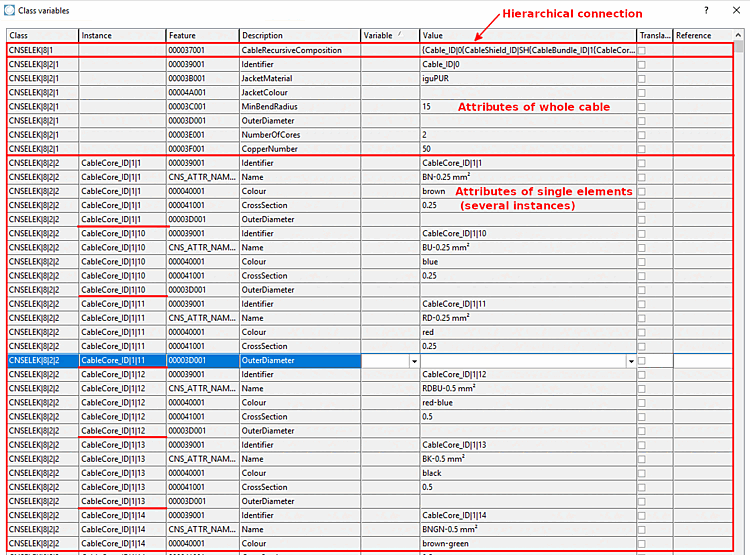In contrast to most of the other electrical parts for cables, a recursive definition of cable properties is sufficient.
Cables consist of the following elements. In the CNS classification, each element corresponds to a specific class:
The cables are described in the CNS classification system on two levels, firstly the characteristics of the individual components (CNSELEK|8|2|1 to CNSELEK|8|2|5) and secondly their recursive hierarchical linking (CNSELEK|8|1).
Definition of the individual cable elements in linear form
Here you can find the attributes of the whole cable and of the single cable elements such as cable bundle, cable shield, cable twist and cable cores.
For example, a cable core has attributes such as name, diameter, cross section, etc. These are written in the typical form of the CNS classification.
The following applies to all classes: The Name and Identifier characteristics must be set (exception: the overall cable has no name), and the identifier must be unique and written in the following form:
Cable_ID_# CableCore_ID_# CableBundle_ID_# CableShield_ID_# CableTwist_ID_#
The hash stands for a sequential number or a combination of a shortcut and a sequential number.
The unique identifier makes these components referenceable and can be interpreted in hierarchical form. This is done using the class
CNSELEK|8|1and its featureCableRecursiveComposition.Details on the individual classes and attributes can be found under Section 5.12.9.19.2, “Definition of the single cable elements in linear form”.
The recursive hierarchical linking of the individual cable elements (CNSELEK|8|1)
This structure takes the single elements with their identifier and arranges them in hierarchical form.
Details on this can be found under Section 5.12.9.19.3, “Recursive hierarchical connection of single cable elements”.
Example: Hierarchical connection (CNSELEK|8|1) - Attributes of the whole cable (CNSELEK|8|2|1) and attributes of the cable elements (CNSELEK|8|2|2 to CNSELEK|8|2|5)


